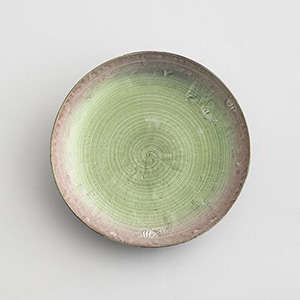KOISHIWARA / 小石原
Koishwara ware originated from the establishment of a kiln in Fukuoka prefecture in the latter half of the 17th century. The special features of this ware lie in the way in which the pottery is decorated using brush strokes on the large dishes and the large pots with their chattermarks. Using techniques which have barely altered over the centuries, urns, drinking vessels and flower vases are still being made today along with a range of tableware and some figurines.
MIKAWACHI / 三川内
The origins of Mikawachi ware date back to the building of a kiln by Korean potters that were brought back to this area of Kyushu by landowners at the end of the 16th century. This ware features gosu (cobalt blue) painting on a white porcelain. They are always created as luxury goods high quality enough to be conceded to the Emperor and the Shogun ever since the opening of the kiln. The products are reputed for its delicate elegance and sophistication.
ARITA / 有田
The origins of Arita ware date back to the end of the 17th century. The potter, Li Sanpei who discovered porcelain stone at Mount Arita Izumi, in Saga prefecture. The porcelain that was subsequently made there was the first to be produced anywhere in Japan. Today as in the past, many fine pieces of Japanese and Western tableware are being produced along side some decorative items. Inevitably, however, it is the brilliance of the enamels and the beautiful white surfaces as well as its practicality, which continue to characterize Japan's most famous porcelain.

3-H-3 ARITA
HASAMI / 波佐見
Hasami ware is characterized by its elaborate clear white porcelain skin and gosu (cobalt blue) paint. In Japan, Hasami ware are produced in large quantities. The pottery technique has brought about the creation of a wide variety of both modern and traditional tableware pieces.
KUTANI / 九谷
The first porcelain to be produced in the Kutani area was in the 17th century, a suitable porcelain clay having been discovered in the area. Kutani ware has multicolored pictures in addition to an inherent distinctive quality. Gorgeous and openhearted linework is colored with green, yellow, red, purple, and navy Japanese pigments, producing a dignified brilliance, characteristic of Kutani ware. The bluish porcelain unique to Kutani helps to bring out the gentle colors of the pictures.
AIZU / 会津
It was the planting of lacquer trees promoted by a powerful local family Around the 14th century that led to the making of Aizu Nuri. The various techniques employed and decorations using auspicious motifs favored by the Japanese are part of the delight of Aizu Nuri. Several techniques are of particular note. Each technique is intelligently employed in the making of bowls, traditional stacking boxes, coasters and trays.
MASHIKO / 益子
The distinctive Mashiko style of pottery developed sometime about the middle of the 19th century having come under the influence of Kasama ware in Tochigi prefecture. Today, using good quality Mashiko clay, some dynamic pieces of pottery utilizing such traditional techniques as a white cosmetic dribble of glaze and brushmark slip decorations are being produced in large quantities.
MINO / 美濃
It has a share of 50% or more of ceramics produced in Japan, and it is regarded as a representative Japanese ceramics. The history of Mino ware is old, and it dates back more than 1300 years ago. The roots are made of Sueki which was made in Gifu prefecture. In the 16th century, the number of craftsmen increased, the size of the kiln increased, and it became a major production area. Many studio and wholesalers exist because of the large scale, and a wide variety of products are made.
KASAMA / 笠間
Kasama ware started making pottery in Ibaraki prefecture around the 18th century, mass-producing and expanding the scale. There are nearly 200 pottery barns, potters and shops dealing in Kasama ware pottery products in the Kasama area of Ibaraki prefecture. The region garners a great deal of attention as its products are primarily hand made, and range from unique, never-before-seen pieces to traditional designs.
KYOTO / 京都
The maki-e technique of laying down gold and silver powders was preceded by techniques which first came into being Around the 8th century, when Japan was under the influence of Tang dynasty China. Kyo shikki, steeped in a long history, is characterized by a profound “wabi-sabi” (aesthetic view centered on the acceptance of transience and imperfection) flavor not seen in wares from other production areas. Its main features are its elegant and sophisticated design, its robustness, as well as the beauty of its two-dimensional and three- dimensional elements and its delicate finish.
YAMANAKA / 山中
TAKATORI / 高取